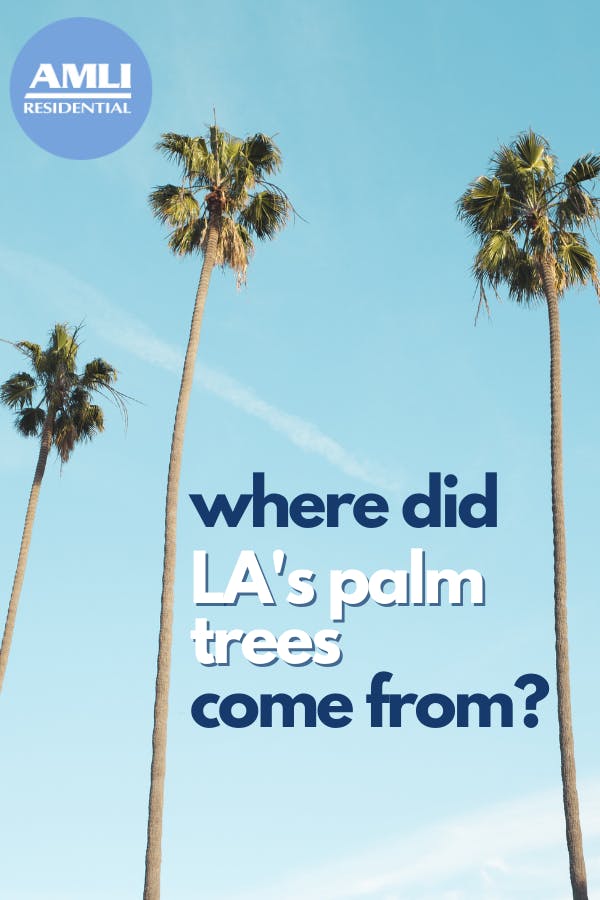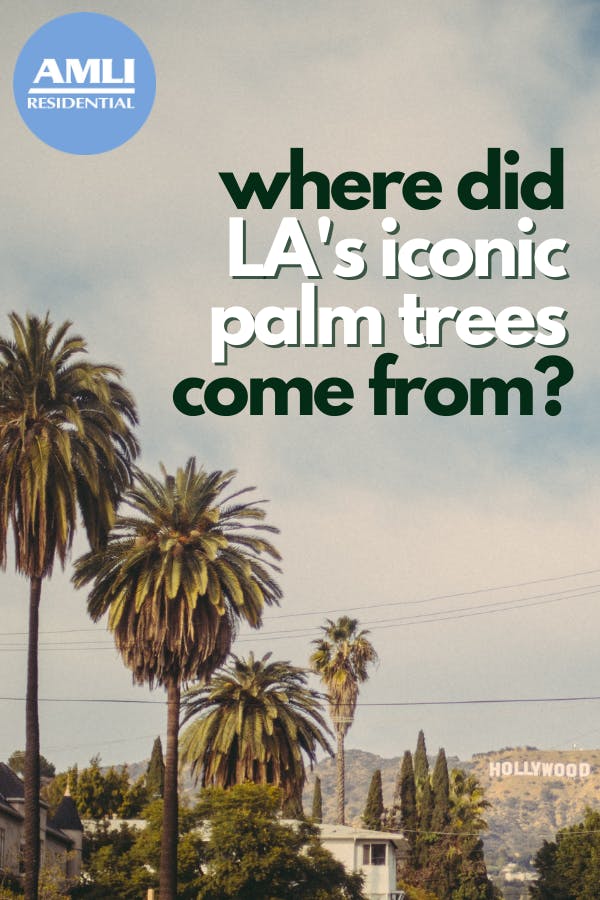When you think of L.A., what do you think of?
Many people think of Hollywood, fame and fortune. Some think of sandy beaches and warm sunshine. Some think of orange groves and fruit trees. There’s no one thing that defines Los Angeles, but one thing’s for sure, many of you might picture Los Angeles’ iconic palm trees.
If you live in our Southern California apartments, then you’ve undoubtedly driven past thousands of Los Angeles’ palm trees in your time. The tall, slender trees that line boulevards and avenues are as much of an L.A. icon as the Hollywood sign or the Walk of Fame. They appear on postcards, on emblems and on T-shirts, and they’ve become synonymous with the glorious, sunny City of Angels. But did you know that most of these towering beauties have little to no native presence in the region? In fact, many species of palm trees have only called Los Angeles their home for the past one hundred years or so.
So, how did this non-native plant arrive in Southern California, and why did it become a symbol for a city that the trees have no natural ties to? We may not be palm readers (pardon the pun), but we sure can dig up the true story of this leafy tree for you all.

Where did Los Angeles' palm trees come from?
Palm trees’ native habitats
Of all the palm tree species lining the streets of Los Angeles, only one species is actually native to the state of California.
The Washingtonia filifera, commonly known as the California palm or the California fan palm, is native to areas within the Colorado Desert and the Mojave Desert. The palm trees sprout up in deep ravines and hidden oases where the trees can draw water from natural springs and be protected from the harsher temperatures.
In these habitats, the towering California palm not only provided shade for smaller plants, birds and animals, but the trees also proved to be a valuable resource for the Native Americans in the region, including both the Cahuilla and Paiutes tribes. The palm’s sweet fruit could be eaten raw or cooked, and could even be ground into a flour for baking breads and cakes! The stringy, fibrous leaves were perfect for weaving, and came in handy when making roofs, baskets and sandals.
When driving through L.A., however, you are sure to see many different species of palm trees, most of which were imported to the region in the early 19th century. The largest population of non-native palms in L.A. are the Mexican fan palms that were imported from Mexico in 1930.
Why were palm trees brought to Los Angeles?
Like we said, the palm tree has become an icon of L.A., but it was no coincidence that made it so.
Palm trees definitely weren't planted in L.A. due to their usefulness, but rather for their ornamental value. They provided little fruit and little shade compared to other urban trees, but they did have plenty of symbolism and were extremely convenient.
Franciscan monks settling in Southern California in the 18th century were the first ones to plant palm trees for ornamental purposes. Just as they planted grape vines in order to provide wine for Holy Communion, the monks planted palm trees because of their significance to Palm Sunday.
Palm trees also held an exotic value to many Europeans, as palm trees are generally native to more tropical and faraway regions. The palm tree began to symbolize warmer climates, sunny vacations and Mediterranean climates. They symbolized paradise, and that symbolism travelled across the Atlantic and spread throughout the United States. It became common practice to decorate postcards and paintings of faraway destinations with palm trees in order to give the destination a more exotic feel.
As a young Los Angeles began to establish itself as an exotic destination in the early 20th century, city planners started to plant the already-exotic trees along the large streets and boulevards all over the city. The palm trees were also much easier to dig up and transplant than other decorative trees because of their simple, bulbous root system, making them the cheapest option for the Division of Forestry’s new street trees.
By the 1932 Olympic Games, over 40,000 Mexican fan palms had been planted as part of a $100,000 city-wide beautification project. The project employed over 400 workers from an unemployment relief program and resulted in around 150 miles’ worth of palm-lined boulevards. At the time, the trees cost only $3.60 a piece.
The palm trees now
Los Angeles’ palm trees were planted for purely ornamental purposes. And, unfortunately, that means that the likelihood of a future lined with palms is slimmer than the palms themselves.
The California palm can live to a ripe old age of 80-250 years, while the Mexican fan palm can live up to 500 years in its native habitat; however, outside of their natural habitats, the trees have a shorter lifespan, and nearly a century has already passed since the ornamental trees were first planted in L.A. The oldest one dates back nearly 150 years and is still standing at Exposition Park where it was transplanted in 1914.
In addition to the inexplicable issue of old age, the iconic palms face a new environmental enemy that threatens their longevity. The red palm weevil, notorious for being one of the biggest threats to palm trees worldwide, made its first appearance in Southern California in 2010 and, although now eradicated from the state, weakened the palm population. Currently, the South American Palm Weevil has been making its way through both native and non-native Californian palms.
As these iconic trees die off, it’s not likely that they will be replaced. Palm trees require massive amounts of water and don’t provide much shade, and the risk of fungal and weevil destruction makes replacing the trees an unsustainable choice. City planners announced that any dead palm trees will not be replaced with more palms; instead, they would be replaced with trees that require less water, offer more shade and will live longer.
At the end of the day, Los Angeles’ palm trees will always be a true city icon. They’ve represented the fantasy and exoticism of the city from the very beginning, and even if the trees die away, the city will always keep those fantastical ideals.
Pin it!

Features photo courtesy Pixabay/rpnickson


 View All Posts by Colleen Ford
View All Posts by Colleen Ford